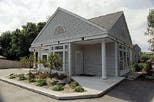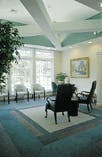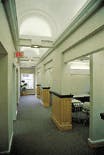Reshaping Your Space
A new look for the practice usually is the best investment a dentist can make.
Harry Demaree, DDS
How do you know when it`s time to start planning for a new facility? What do you do first? These are questions we hear several times a week and they`re excellent questions. Just as frequently, we hear doctors say, "I`ve just leased a space and I`m ready to start design." Usually, they have not determined if their anticipated dream office is economically feasible, if they have chosen the best option, what their budget is, whether or not the financing they`ll need is available or many of the other aspects of planning for the most successful possible result. This usually is the greatest investment dentists will make during their career. It warrants a thoughtful analysis, planning and decision-making process. So, let`s start at the beginning.
When is it time?
How do you know when it`s time? The first indicator is the amount you are producing in your current facility. Many management consultants use a factor of $10,000 to $15,000 production per operatory per month to determine if the dentist is reaching maximum potential in his or her current office. We have found this to be an important consideration as well. When a doctor tells us he is producing significantly less than that, our recommendation usually is to seek good management help before proceeding with a new office. Even in poorly designed facilities, sound management systems for appointment scheduling, financial arrangements, effective new-patient examinations, verbal-skills training and an active recall system can bring a struggling practice to a point where a new facility can be considered without great financial risk.
Other factors also may contribute to a lower than optimal monthly production. Among them are: frequently running behind schedule (not enough operatories, inadequate sterilizing area, poorly designed or cramped operatories, crowded conditions causing high stress), lack of (or poor) areas for financial arrangements and congestion at the appointments area. One of the most overlooked problems is lack of enough business space to administrate the potential production per operatory. Consistently high production goals are almost never met in those cases. A common rule of thumb is one administrative staff member for every $20,000/month in production. Another factor to be considered is the percentage of acceptance of comprehensive treatment plans in the practice. We find that most doctors don`t know that this is an important indication of practice success. If your acceptance rate is less than 80 percent of treatment presented (assuming comprehensive plans are offered to each patient), then one (or both) of two culprits likely is at work:
Ineffective verbal skills - Most management consultants take a close look at the verbal skills of the dental team when starting with a new client.
A poor reflection of your commitment to quality care by the appearance of your office - When your environment is not congruent with what you`re expecting your patient to accept, then expect your acceptance rate to be significantly lower than it could be. It`s common for a doctor who has just moved into a new office to report a high incidence of existing patients asking for treatment that was presented years before. But that only occurs when the new office has a visual image that is consistent with the quality of care provided. Remember that 93 percent of communication is nonverbal. People react much more to what they see and feel than to what they hear.
Remodel, lease or build?
Remodeling usually is the least optimal choice unless sufficient additional space can be added and the construction can be phased so that production is not lost due to partial or complete shutdown of the practice. It`s possible to lose up to 50 percent of production for two to four months. A high percentage of doctors who have been through a major remodeling while trying to conduct a busy practice say that, even though they are pleased with the result, they would never do it again. Instead, they would move to a new space. Leasing a new space is a good choice when land is not available in appropriate amounts at a reasonable price or if you don`t have a sufficient down payment. A new building usually is the best choice, when possible. Our studies show that the average doctor who builds will be, over a 20-year period, more than $500,000 ahead of where he or she would have been had he or she leased and invested the down payment in a mutual fund.
Once you`ve determined your preference, it`s time to compare the numbers against your other possible choices. This is best done by comparative financial- feasibility studies. The point here is to go beyond the determination of total cost of the project and then deciding in favor of the lowest-dollar-amount project. While that`s a start, it doesn`t give you enough information. You must determine the monthly impact by arriving at the additional amount you must produce to at least assure your current net income. Next, determine if your demand for services (healthy new-patient flow, fully scheduled two to three weeks ahead, inability to keep up with recall, etc.) is enough to supply the needed increase.
Doctors for whom we`ve designed offices over the last 18 years have had production increases averaging $16,000 per month (an average 34 percent increase) within the first two to three years in the new office. Our most recent three-year survey showed that 80 percent of these doctors had increases sufficient to cover their increased expense by the end of the first year in their new facility. Obviously, the first several months in a new facility require careful planning (such as reducing personal expenditures, raising fees before you move in, arranging for deferred payments with the lender for the first several months, etc.) until production increases begin and collections catch up.
If you have now determined what you want to do and how much you`ll need to borrow, your next step is to have lenders qualify you. They should be able to tell you the amount they`ll lend based on what they believe will be your ability to repay the loan. It`s important to work with lenders who have extensive experience with dental loans for capital improvements like the ones you are considering. If a lender has little experience with how a well-designed, high-image office can affect a practice, that lender usually will not commit enough to fund the project you want. He also may try to convince you to do something of a much lesser nature. The design professionals you chose (as well as the ADA) should be able to direct you to knowledgeable lenders.
What kind of construction costs are you likely to encounter for the new office? Assuming you have an optimal amount of square footage for the function you want, national averages for "finishing out" an existing building range from $60-$75 per square foot. This is for a highly functional office with a very simple esthetic design. Anything less usually means you`re leaving something out of the cost (e.g. custom cabinets) or you`re eliminating some of the functional aspects (e.g., optimum lighting). Costs higher than that usually mean you`re including some esthetic quality to your new office to enhance your credibility with your patients. Be careful here. Costs per square foot are tricky. As an X-ray is to actual diagnosis, cost per square foot is to actual construction costs. It`s a place to start, but expect and plan for variations as the project progresses.
It`s important to realize that construction costs are only about 50-75 percent of the total project cost. Some other significant costs that must be factored into this are professional fees, interest on loans, land, landscaping, new dental equipment and new furnishings. Make certain you plan for nice artwork. It speaks volumes to your patients about your attention to detail.
You should expect architectural fees in the range of 10-15 percent of the construction budget. The days of "free" plans that you give to a builder are nearly at an end. Most municipalities require plans sealed by a registered architect before issuing building permits. If you give a free plan to a builder, it`s likely the builder will have to take it to an architect to produce a set of plans for permitting and from which they can build. You`ll then pay the builder for the architectural services up front or in the cost of construction.
Using free plans to build an office that will affect you and your practice for the next 10-20 years is like carrying out a treatment plan that was created by a laboratory technician for your patient. If you believe a high degree of professionalism is imperative for your patients` well being, shouldn`t that same degree of professionalism be imperative for the well-being of your practice?
Some common misconceptions
"Six months should be plenty of time to plan and build a new office." The steps we`ve outlined here easily could take two months. Thoughtful and complete design and documentation will take two to four months. Pricing and permitting processes could take one to two months. Construction will take three to five months. We`re now at eight to 13 months and we haven`t yet included time for the two hardest parts of the project. Finding a space and signing a lease can take two to six months or more and finalizing a loan can take one to three months or more. So the timeline for a lease space could be one to two years - more if you build a new building.
"It will cost less in my town." I`d love to have a dollar for every time I`ve heard that. The fact is, it rarely costs less in your town. The point is, plan for it to be higher than what you`ve heard it will be. If it`s not, you win. If it is, you`ve planned for it.
"I can`t do anything that looks too good because my patients won`t like it." You`re right, they won`t like it; they`ll love it if you build a quality (not a glitz or a gimmick) statement that reflects your commitment to them. Patients may resent big, personal expenditures you make because they can`t participate in them. However, They`ll love the professional expenditures you make because they can share in them. They`re for their benefit! Our experience with doctors in small towns, and "blue collar" as well as "white collar" areas of large cities, has been 100 percent favorable with regard to their patients` reactions.
We`ve discussed the financial and public perception benefits of a well-planned, high-professional-image office. We also should include some of the less tangible benefits as well. Foremost is reduction of stress. If your office functions well and is a visually and physically enjoyable place to be, stress goes down. Doctors consistently have reported that even their more difficult patients are easier to treat. Next, doctors find that attracting high-quality staff and reducing turnover are big benefits. One doctor reported that her office was a Ostaff magnet.O Many have lists of potential employees waiting for a job.
Increased patient referrals are likely. A doctor recently told us that, after he moved into his new office, several patients have told him, ONow we can refer our friends to you.O What we?re describing is a higher quality of life. A doctor?s spouse told me that while the extra income is nice, what she likes most is that her kids have a father and she has a husband again, instead of the chronically tired Ocouch potatoO they had before the new office.
If you?re starting to think about a new office, make certain you allow for enough time to do the preliminary homework we?ve described here. In other words, educate yourself, consult experienced professionals and make informed decisions so that you do it right the first time. After all, you?ll be living with the result for the next 10-20 years.
Generally speaking, if there still is affordable land in your area and you can afford a down payment, building an office is usually the best financial choice. If you decide to build, design the inside first, then wrap the exterior around it. Office shown: Dr. Jonas Gavelis, Rockport, MA.
When establishing your budget, be sure to include furnishings and artwork in the total project cost. The finishing details provided by the interior designer, coupled with interesting architectural elements, make this reception room elegantly inviting. An environment such as this attracts both quality patients and staff. Office shown: Dr. Kent Guebert, Bourbonnais, IL.
Know that every part of your office makes a statement. Notice the attention to detail in this corridor. Patients may not be consciously aware of the lighting, ceiling design and trim work, but they will get a subliminal message that this office is committed to quality. When this statement is consistent throughout the office, even in the corridor, case acceptance goes up. Office shown: Dr. Jonas Gavelis, Rockport, MA.



